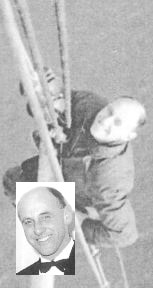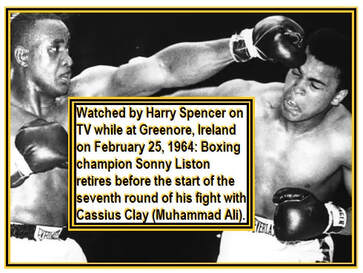|
Prince Charles explains 'pebble theatre'.
|
PEBBLE
|
|
Don Pierson [right] explains how a young Prince Charles made a request to join the Radio London fan club. |
|
|
Prince Charles explains 'pebble theatre'.
|
PEBBLE
|
|
Don Pierson [right] explains how a young Prince Charles made a request to join the Radio London fan club. |
|
 During the time that George Saunders was at Greenore, which appears to have been after Friday, March 13, 1964, since the mv Mi Amigo was already there, but as previously noted, it was before Tuesday, March 23, 1964, when the mv Caroline (ex-Iseult; ex-Fredericia) departed; Harry Spencer [shown left] was already at work on the mv Caroline. Spencer has often repeated to several people, an apocryphal tale involving the anti-English attitude of Aodogán O'Rahilly, who was the father of Ronan O'Rahilly. According to Spencer, not only did Aodogán O'Rahilly not like Spencer simply because he was English, but he would not even look at him when talking about him when Spencer was present. According to Spencer, Aodogán O'Rahilly turned his chair around so that only his back was visible to Spencer. This is most peculiar for several reasons. First of all Aodogán O'Rahilly was by birth an Englishman having been born at Hove near Brighton. Second, the impression that has been created is that Aodogán O'Rahilly owned a 'port' at Greenore, and his son Ronan negotiated its use for his own 'Caroline' project as well as the 'Atlanta' project of Allan James Crawford. But this is another apocryphal tale lacking veracity. We know that the 'Caroline' project was not originated by, or even managed by Ronan O'Rahilly who was but a convenient stooge thrown to the press by a PR firm. We also know that Greenore was neither a 'port' at the time, and neither was the land adjacent to the waterfront at Greenore, owned personally by Aodogán O'Rahilly. The true story is that the disused railway terminal at Greenore had been bought at auction several years before, by a building company managed by Aodogán O'Rahilly. At a second auction some time later, a disused railway hotel adjacent to the railway terminal had also been bought by the same building company which was not even located at Greenore. The plan for these auction purchases was to demolish all structures on the site; clear away the rubble, and then to build a new factory and use part of the land for the movement and parking of heavy duty trucks and trailers. However, the building materials company did not have the money to go ahead. This is where the 'useful stooge' named Ronan, was brought in to get his Irish Republican father to let 'friends' of his son go ahead and equip two ships at the water's edge, and to also use the adjacent land for construction purposes. To sell this idea to his father, Ronan did not refer to the name of an Englishmen, instead, he used the name of Australian Allan Crawford. Behind Crawford was an Irishman named Charles Orr Stanley who had extensive business interests in the Republic, and a family home near Cork. So when Spencer and other Englishmen started popping up at Greenore and Aodogán O'Rahilly got to hear of it, he was none too pleased. George Saunders does put his own visit to Greenore within the context of work already being carried out by Harry Spencer. Saunders also observed that as an Englishman he found the location to be somewhat unfriendly. While he was on the mv Mi Amigo at Greenore, Saunders was told that ".... we need quite a bit of work doing yet, it’s not ready to go. This ship has been on the air previously but the aerial has to be rigged." That remark referred to the ongoing work of Harry Spencer.  Because Harry Spencer was the person who rigged the masts on both the mv Caroline and the mv Mi Amigo, it is helpful that Harry Spencer provided us with a time-marker. In his own account of work at Greenore which appears in the Appendix to Humphries' book (as noted earlier), Spencer says that he watched the famous "Sonny Liston and Cassius Clay" fight on television while he was at Greenore. The date of that boxing match was February 25, 1964. This date is also important because it provides for more inter-connectivity in this singular project involving two radio ships. That inter-connectivity is provided by details of the business relationships between Harry Spencer and John Howard Gilman and Allan James Crawford and Captain De Jong Lanau. Gilman seems to have been the second man in the broadcast team headed by Alfred Nicholas Thomas. It was Thomas who had retired from the BBC in 1959 and begun working for one of Charles Orr Spencer's Pye Group of companies. The first assignment Thomas had under this arrangement was to work on the VRON/CNBC project, but it failed due to lack of money on the Dutch side of the operation. Thomas brought in Gilman and then Gilman bought in Saunders for approval by Thomas. But it is even more interesting to note that Gilman performed work for both the mv Caroline and mv Mi Amigo, and that he could not have done so until Spencer had been hired by Captain De Jong Lanau! However, dependent upon all of that was the coordinated sailing of the mv Mi Amigo from Galveston, Texas with McLendon engineer Milan Leggett on board; and the almost simultaneous purchase of the mv Fredericia which was then towed by Wijsmuller from Copenhagen to Wijsmuller facilities near Rotterdam! Spencer explained in the Humphries' Appendix how he designed the custom-built masts for both the mv Caroline and mv Mi Amigo, to which he then attached antennas to each mast that had been designed by John Howard Gilman. We also know from the original account provided by Alan Bednall that was recovered from Wroughton archives, that the involvement by Charles Orr Stanley in masterminding all of this was regarded as 'top secret'. Even the board of directors of the Pye Group of companies in Cambridge were not aware of how this operation was being conducted on a military "need to know" basis. Everyone worked through intermediaries where necessary. We can trace the first meeting between Harry Spencer and Alfred Nicholas Thomas back to Allan Crawford's office/studio at 47 Dean Street in the Soho District of London. That is where Spencer met both Ronan O'Rahilly and Captain de Jong Lanau, Chief Superintendent of Wijsmuller Towing Company , for the very first time. We know now that Spencer was at Greenore with both Thomas and Gilman before Saunders arrived, and we also know that Spencer was at Greenore before February 25, 1964 when the Cassius Clay fight was televised, and thus we also know that Planet Productions Limited would not be registered for the very first time, and in Ireland, until two days after that famous boxing match. If Planet Productions Ltd did not exist until February 27, 1964, but both ships had been obtained during the closing hours of December 1963, and work was underway on both of them at Greenore; then, in the minds of most people who have been following this story, that would only leave Project Atlanta Limited as the driving force. But that company which had been registered in England during August 1, 1963, had only a skeleton board of directors at first, and the big money names did not join its board of directors until some time had passed, after that date. So who was really running this 'show'? More tomorrow .... Comments are closed.
|
Our team produced this free radio program for PCRL in Birmingham.
It was repeatedly broadcast on and after October 20, 1985. Click & listen! Blog Archive
August 2023
Copyright 2021 with all rights reserved.
|
Index |
Library |
|
